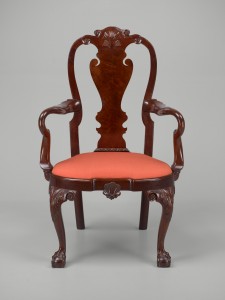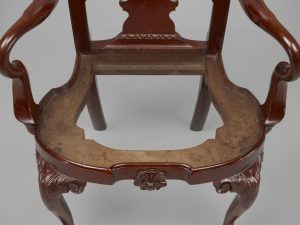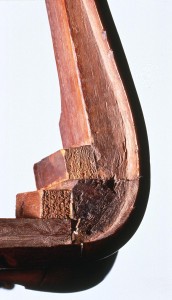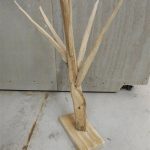We may receive a commission when you use our affiliate links. However, this does not impact our recommendations.
Last Friday I talked about through mortise-and-tenon joinery in 18th century chairs in my post “Furniture Details: Why Philadelphia is Just Better.” In the post I mentioned through mortises are not the only differences between Philadelphia chairs and chairs from other regions. This week I wanted to discuss another difference – seat construction.
I’m not referring to the actual slip seat on which you sit; I’m talking about how the chair is actually constructed. Specifically, I’m want to look at Queen Anne balloon seat chairs this time out. Sure they’re fancier than most people are going to attempt to build in their shop on weekends but there’s still lots to learn by looking at them and how they’re made.
Let’s be clear, I’m not talking about the aesthetics of the chairs in this post. I’m talking construction techniques and why one is just better built than the other. Both chairs are the products of masters working at their peak.
Looking at both chairs your first clue that one is more sturdily built is a noticeable lack of stretchers. If you consider last week’s post, the stretcher-less chair is from Philadelphia – those stretchers on the Newport chair aren’t merely decorative. There’s lots of other design details that give you clues to the origins of both chairs, but that’s a Wednesday discussion. Today we’re interested in how they’re constructed.
When you look closely at the two chairs, you can see the front legs on the Philly chair appear to end at the bottom of the seat frame; the Newport legs run straight through. This points to a major difference in construction (other than the seat rails on the Philly chair are tenoned completely through the rear legs). Both chairs are what we call “compass” or “balloon” seat chairs, which means they both have somewhat horseshoe shaped seats. So, how different is the construction and why are they made differently?
The answers to both questions are actually pretty simple. The construction of the two chairs is completely different and the reason is how the craftsmen thought about how chairs are built. The Newport chair is a little later, chronologically, than the Philly chair but, in this case, that’s not a major factor in why they’re constructed differently because the newer chair is more similarly constructed to chairs of the William & Mary (and earlier) period than the older one.
Both chairs have two side rails, a front and back rail and four legs. The Newport chair is basically constructed using thinner material that is set on edge and joined to all four legs. The Philly chair is made with thicker material that is laid flat. The side rails are tenoned into the front rail essentially creating a frame. Its front legs are then joined to the underside of the seat frame. It actually has round tenons that are brought through the frame at the point where the seat frame mortise-and-tenon joints come together – the leg tenon acts almost like a peg locking the seat joint in place.
If you look at the side rail to front leg construction on the Newport chair, you can see the side rails are tenoned into the front legs; the upper blocks of which are heavily rounded to create the horseshoe shape. This means the tenons on the side rails have to be rather short or they’ll end up poking though the blocks of the legs. Short tenons means less hold and that means you need stretchers for additional strength. The last thing you would have wanted at your “Victory over King George” party is to have a drunken attendee punt your chair leg across the dining room as they stumble about socializing.
Another advantage of building chairs the Philly way is you can get more dramatic curves as part of your design. Just compare the curves of the two chairs at the point where the front legs reside. Whether you like the more dramatic curve or not is a matter of design preference – and that, again, is a topic for a Wednesday discussion.
So, why are the two chairs constructed the way that are? It comes down (as many things in the 18th century do) to wealth and fashion. Philadelphia was by far the largest and wealthiest city in the colonies. The best, most highly trained craftsmen flocked to the city to vie for the most well-healed patrons. With them they brought the newest and most innovative construction techniques and design details. That’s not to say there were not wealthy patrons to be had in Newport or Boston, but the craftsmen were not as up on the latest London fashions as their Philly counterparts.
The Newport (and other New England) chairs were constructed using the same mindset as a Jacobean or William & Mary chair; essentially four rails joined to four legs with mortises and tenons. They knew enough about the latest fashion (horseshoe seats) to make the rails a little thicker so they could saw the curves – their Philly counterparts just kicked it up a notch.
Here are some supplies and tools we find essential in our everyday work around the shop. We may receive a commission from sales referred by our links; however, we have carefully selected these products for their usefulness and quality.













Great article and I enjoy the detail pictures.
Thank you for this series of posts. I’m feeling a real need to try some of these techniques out. While I won’t be building chairs this highly stylized, I would like to build joints this bullet proof.
Hi Chuck,
Would it be possible in future posts, when you are comparing joint construction, in this case the corners where the legs are joined, to have as sketchup of the joints being compared? I sometimes have trouble visualizing how things go together. I’m pretty sure I got this one though.
Thanks.
So when can we expect to see a chair project FROM YOU in the magazine?